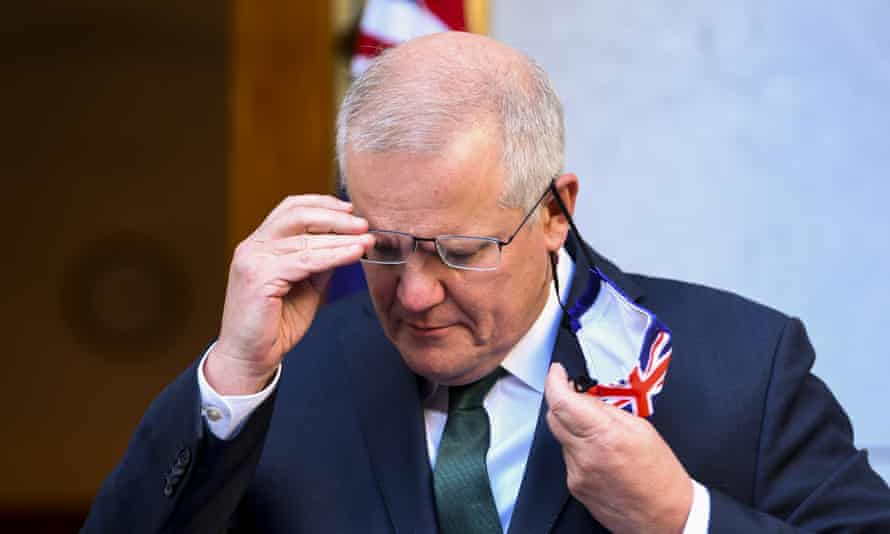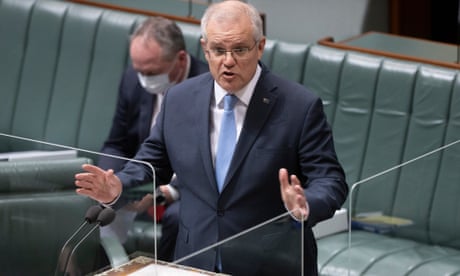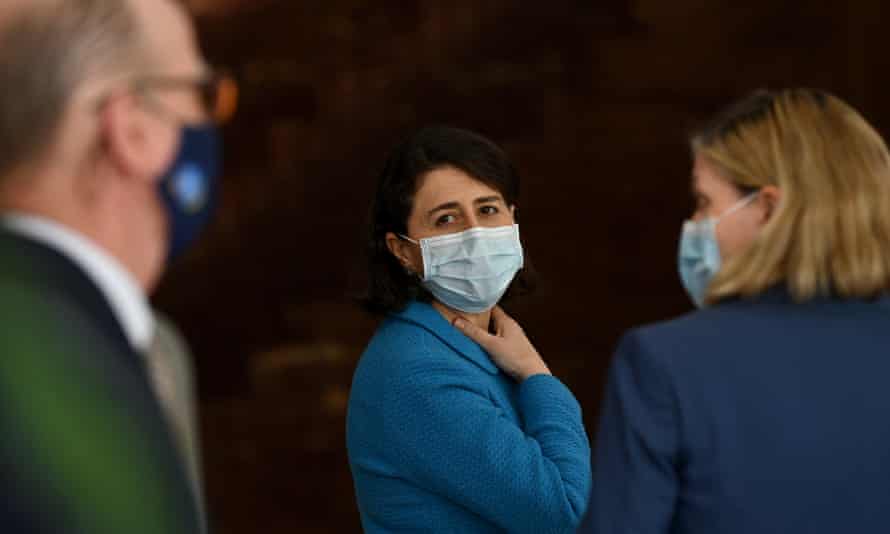Extract from The Guardian
What’s coming is a huge (politically risky) dismount from a public health strategy labelled suppression but more like elimination.

Last modified on Sat 28 Aug 2021 10.15 AEST
I’m not sure exactly when the word “safe” was added to the word “plan” in prime ministerial sentences, but it crept there sometime during this parliamentary sitting week. I noticed this particularly on Thursday. “Our national plan is a safe plan,” Scott Morrison told reporters in his courtyard at Parliament House. “It’s the safe plan to ensure that Australia can open up again with confidence.”
In case you’ve missed it, the “safe” plan is the four-phase strategy to reduce public health restrictions once vaccination rates in the population aged over 16 reaches 70%. Epidemiological modelling from the Doherty Institute informs the strategy. If you’ve tuned in this week, you’ll know the Doherty modelling is being buffeted by two headwinds – rolling disputes within the federation, and the more polite zone of expert disagreement. These crosscurrents are all pretty interesting, but this weekend, safety is what I want to consider.

“Safe” is a courageous word for a prime minister to lob in a pandemic, because pandemics aren’t safe events. It’s certainly true that Australia has endured less tragedy than places like the United States. But we aren’t safe from this virus, and most people know that.
At the risk of stating the obvious, pandemics bring anxiety, illness and sometimes death. People either get sick, or they worry about getting sick. Australian governments have imposed lockdowns to keep people safe, but that physical safety carries a cost. Mental wellbeing suffers.
What Morrison wants to do over the coming weeks is nudge Australians past his previous shibboleth of saving “lives and livelihoods”. “Lives and livelihoods” was the bulletproof political mantra that allowed the prime minister to take actions during the crisis that centre-right governments wouldn’t normally countenance. His new mantra will be “living with Covid”.
Morrison shouldn’t compound bad judgments by peddling false comforts
But “living with Covid” is a different experience for Australia. Morrison’s “safe plan” involves gradually turning off the commonwealth money machine. As vaccination rates rise, it also involves decoupling from a public health strategy that has been labelled suppression but is more like elimination.
Slogans like “safe plan” sound like insurance, but this transition is risky, both practically and, of course, politically. Morrison is beginning this dismount when his political capital has ebbed from the highs of 2020.
People are anxious, and angry. They’ve endured the commonwealth’s terrible vaccination bungle. People in Sydney are also living with Gladys Berejiklian’s failure to lock down the city fast enough. In fairness to the premier, it is possible Delta would have vaulted right over the state’s “gold standard” contract tracers even if she’d locked Sydney down sooner, because the evidence suggests this variant is a pitiless adversary.
But Berejiklian didn’t try hard enough.
That’s the truth.
It’s galling then, to tune in every day at 11am to watch the NSW premier reframing her abject failure as an act of courageous leadership. Berejiklian presents herself as a pace-setter, the only premier with the bottle to speak unvarnished truths, like the elimination of community transmission is impossible (unlike those panicky Labor premiers with their fingers wedged in the Delta dyke).
But this is a found strategy; a virtue of necessity.
As Berejiklian confirmed the new daily record, she softened the blow by promising people a picnic. Now I love picnics, and perhaps this was a cut-through morale boost for Sydneysiders locked down for nine weeks. But from my vantage point in Canberra (locked down for a fortnight) this looked pretty surreal.
Adding to the strange was Nationals leader John Barilaro informing viewers regional communities were “a tinderbox ready to explode” with new Covid-19 cases – as if he were somehow detached from these events – like he was David Attenborough narrating a wildlife documentary. It was certainly “Barra’s” most memorable observation since accusing Covid-infected Canberrans of defecating secretively in Merimbula.
Between the picnic and the tinderbox and the ambulances ramping outside Sydney hospitals, Chant, who soldiers on most days next to Berejkilian, added a useful corrective to the “safe plan” evangelism in Sydney and in Canberra.

She said vaccine equity was one of the necessary preconditions of being able to live with Covid. It would be important to vaccinate the homeless, Indigenous people and other vulnerable populations because Australia was only as safe as our most vulnerable person. Proving her point, by the end of Thursday we learned that Wilcannia had a higher transmission rate than the worst hotspots in Sydney – and no ventilators.
The weird thing about Thursday’s 1,000 cases milestone was my profound sense of deja vu. I remember very clearly last March, 22 March to be precise, the day when Australia sprinted past 1,000 cumulative coronavirus cases. Unlike now – when 1,000 cases (daily) gets presented to people as a minor speed bump on the road to whatever Covid-normal is – last March, 1,000 cases (cumulative) was the trigger for Berejiklian and Victorian premier Daniel Andrews to force Scott Morrison’s hand on lockdowns.
Over the weekend of March 21 and 22, the two premiers demanded a lockdown of all non-essential services. If you’ve forgotten that time, Berejiklian was battling the fallout from the Ruby Princess debacle. Making matters worse, Sydneysiders had ignored the (still novel) polite advice about social distancing, and hit Bondi beach en masse. A glorious autumn had followed the summer of calamity when wildfires turned the sky mustard yellow or pitch black, and sometimes red, like Hell had yawned, and people yearned for breathable air, and restorative sand and surf.
The point of this reminiscence is to map the counterpoint. Last year 1,000 cases pushed Australia into our new public-health driven normal – masks, density restrictions, lockdowns. Now, as NSW passes a milestone of 1,000 daily cases, we have the “safe” plan to transition to Covid-normal.
So let me repeat, nothing here is “safe”.
It might be necessary now, to move past the safety-first world that Berejikilian and Andrews created at the opening of the pandemic. It might be sensible to rebalance the responsibilities between governments and individuals once vaccination rates rise, because the duty of care of the state to its citizens isn’t infinite.
It is certainly prudent for the governments of the federation to try and reach agreement about what restrictions get eased when. It’s likely true that suppressing community transmission is difficult with this variant, so if that’s the reality, policies need to adjust accordingly. In periods like this, choices bend towards the greatest good for the greatest many rather than chasing the impossibility of first-best policy.
It is also important for government to listen to the tolerances of their communities. It’s pretty obvious that some people are now so sick of lockdowns they would prefer to take their chances with a potentially deadly virus rather than remain in the artificial world of harsh restrictions. Morrison is very obviously genuflecting to that constituency.
But not everyone possesses that mindset.
So let’s be clear about the limits of safety. This “safe plan” isn’t safe for the people who will get very sick with this virus and die over the coming months. It won’t be “safe” if testing, tracing and quarantine can’t keep pace with new outbreaks. It won’t be “safe” if the variants after Delta can’t be contained with vaccines. It won’t be “safe” for people who can’t overcome their hesitancy about vaccines, or don’t have the tools to properly weigh the risks. It won’t be “safe” to open the international border when large swathes of the world’s population don’t yet have access to a vaccination.
Bear in mind too that the Doherty Institute modelling only considered the “transition” phase over the next six months. It doesn’t consider how relaxed restrictions will ultimately affect transmission in the community because the environment is too uncertain.
Of course we need to move forward, rejoining each other and the world, and vaccination gives us the tools to do that. We can’t expect governments to eliminate every risk. But we also need to approach the coming dismount with eyes wide open.
The prime minister has made a number of very poor judgments this year.
He shouldn’t compound bad judgments by peddling false comforts.
No comments:
Post a Comment